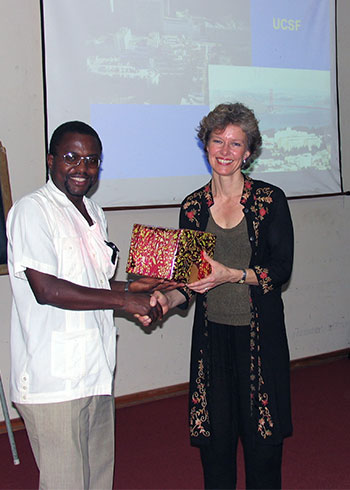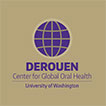
As a clinician-scientist with expertise in oral medicine and epidemiology, my research experience focuses on the oral complications of various forms of immune dysfunction. Although I was born in Denmark (from a Danish mom and a French dad) my journey as a dentist started in France where I spent my formative years and young adulthood, attending dental school at the Université René Descartes Paris V. My involvement with research began several years later at the University of California, San Francisco (UCSF), where I had completed an Advanced Education in General Dentistry (AEGD) program, then enrolled in a T32 NIDCR-funded Dental Clinical Epidemiology program with the first year being spent at the University of California, Berkeley (UCB), earning a Masters of Public Health (MPH) in Epidemiology.
Having spent a weekly rotation in the UCSF Oral Medicine Clinic in my second year of AEGD, dividing my time between Deborah Greenspan’s and Sol Silverman’s respective clinics, I had gained much clinical experience in the diagnosis and management of HIV-related oral manifestations. Thus, the application of epidemiology to the developing field of HIV-related oral diseases became a natural focus of my research interests in the early stage of my career as a clinician-scientist. I was very fortunate to benefit from exceptional mentorship from John Greenspan, a renowned BDS-PhD oral pathologist and scientist at UCSF, who had been awarded one of the largest NIDCR-funded Program Project grants that focused on both the pathogenesis and the epidemiology of HIV-AIDS-related oral diseases among adult men and women in San Francisco. Following his advice, I applied for a Dentist-Scientist Award (K15) at NIDCR, which was funded in 1994 and enabled me to earn a PhD in Epidemiology at UCB while completing a 3-year residency in Oral Medicine at UCSF. As part of my doctoral research, in addition to exploring specific risk factors that may exacerbate the occurrence of oral mucosal lesions in adults with HIV disease, I conducted a survey on the utilization of dental care among HIV-infected women participating in the Women’s Interagency HIV Study (WIHS). After completing my PhD, I implemented a collaborative study with my colleague Midion Chidzonga, an oral and maxillofacial surgeon, then the founding Chair of the Department of Dentistry at the University of Zimbabwe Faculty of Medicine and Health Sciences in Harare, where he later served as Dean. The aims of the study were to explore oral candidiasis as a surrogate marker of HIV disease progression among women in Zimbabwe, while assessing the sensitivity and specificity of oral candidiasis diagnoses made by trained nurses. The study was funded by an AIDS-related Fogarty grant directed by Art Reingold at UCB and an R03 from NIDCR. A highlight of my four visits to the University of Zimbabwe in Harare from 1999 to 2005 was the opportunity to teach oral medicine to dental students in the recently established Department of Dentistry led by Midion Chidzonga. During my typically 8 to 10-day visit I would spend each morning at the university delivering lectures on oral mucosal diseases to a very receptive and enthusiastic group of students, which made the experience extremely rewarding.

Subsequently, I was the initial Chair of the Oral HIV/AIDS Research Alliance (OHARA), a multicenter grant that was part of the AIDS Clinical Trial Group (ACTG) Network. OHARA, which was funded by NIDCR from 2006 to 2014, brought together three centers of excellence: a Virology Unit led by Jennifer Webster-Cyriaque and Dirk Dittmer at the University of North Carolina at ChapeI Hill, a Mycology Unit led by Mahmoud Ghannoum at Case Western University, and a Clinical Epidemiology I led at UCSF. Our team led the development and implementation of multiple study protocols pertaining to the oral complications of HIV in the US, Haiti, Africa, and India. I also was fortunate to be part of the leadership team of an oral health study conducted among youth participating in the pediatric HIV/AIDS Cohort Study (PHACS), as part of which we explored the role of gingivitis and periodontitis, oral inflammatory cytokines, and the oral microbiome on systemic immune activation. It was in the context of my experience with HIV-related oral disease research that I had the opportunity to collaborate with Ana Seminario as a consultant on her R56 planning HIV grant in Peru.
Concomitantly, and over the past 22 years, I have also been the lead Epidemiologist of the NIDCR-funded Sjögren’s International Collaborative Clinical Alliance (SICCA), initially established by Troy Daniels and John Greenspan, and became its Principal Investigator (PI) in 2010 together with co-PI Lindsey Criswell, a geneticist and former Chief of the Division of Rheumatology at UCSF (Dr Criswell has since moved to NIH where she is the Director of the National Institute of Arthritis and Musculoskeletal and Skin Diseases, although our fruitful collaboration with her laboratory at the National Human Genome Research Institute continues through a cooperative agreement grant mechanism). More than 3500 participants with signs/symptoms suggestive of Sjögren’s disease (SjD) were recruited as part of SICCA from six international sites (in Argentina, China, Denmark, India, Japan, and the United Kingdom) and three US sites (at UCSF, Johns Hopkins, and University of Pennsylvania), yielding the largest SjD biorepository and data registry in the world, which is still available today to investigators worldwide to conduct SjD pathogenesis, epidemiologic, and genetic studies. Thus, over the past two decades much has been learned about the phenotypic features of SjD, and a genome wide associations study (GWAS) was performed, as part of the SICCA project. Together with my husband Stephen Shiboski, a Professor in Biostatistics at UCSF, we led an effort involving SICCA investigators to develop and validate new classification criteria for SjD using a data-driven expert-clinician consensus-based methodology. These criteria were approved as provisional by the American College of Rheumatology (ACR) and published in 2012. They paved the way to an international effort Stephen and I led to develop/validate a definitive set of criteria approved by both ACR and the European League Against Rheumatism (EULAR) in 2016, and that has now been universally endorsed by the international SjD scientific community with the following publication being cited over 3000 times.

More recently omics and epigenetic data were generated from SICCA specimens as part of a NIDCR-funded U01 grant, SICCA Next Generation Studies, enabling high impact studies of underlying SjD biologic pathways. SjD is also one of four autoimmune diseases to be studied as part of the Accelerating Medicines Partnership® Autoimmune and Immune-Mediated Diseases (AMP®AIM) Program. AMP®AIM was launched in 2021 with the goal of deepening our understanding of the cellular and molecular interactions that lead to inflammation and autoimmune diseases. To-date the Sjögren’s Team for Accelerating Medicines Partnership (STAMP) has enrolled nearly 400 adult participants with signs and symptoms suggestive of SjD from sites at UCSF, UCB, Johns Hopkins, the Oklahoma Medical Research Foundation, and NIDCR. The knowledge gained through these studies, based on molecular deconstruction and reconstruction using cutting edge technology, will advance the development of new and enhanced treatments for autoimmune diseases, including SjD.
In summary, I feel very grateful for the outstanding mentorship I received at UCSF and the exceptional colleagues from multiple disciplines and institutions, in the US and abroad, I have had the opportunity to work with and learn from over the past 30 years. It has been an amazing journey full of varied learning experiences which continue to this day. Furthermore, Oral Medicine has played a critical role in multidisciplinary efforts to understand diseases linked to severe immunosuppression, such as HIV/AIDS, and to autoimmunity like SjD.
